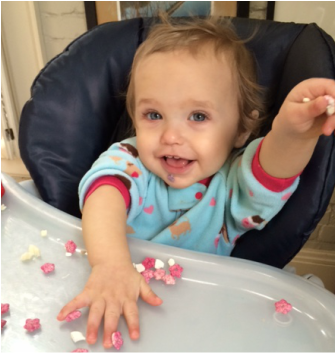 My one-year-old daughter talks constantly. Truly. Constantly. She has her own language. She goes on and on, high and low, back-of-the-throat to the top-of-the-lungs, making all kinds of odd and funny sounds. Her brows furrow (got that from Dad). Her eyes look around for some acknowledgment. She pauses. Smiles. My wife and I talk back, acknowledging, reinforcing, and doing all we can to encourage her expression. But, she quickly becomes frustrated (also from Dad). First the arms go up! Then they start waving around. The hands slam down. She arches her back, torques her body left and right. The “sweet” sounds of a baby start to be replaced by shrieking sounds of frustration. The pitch gets higher. The crying begins. Now, she’s just angry. We scramble to hand her food. Water. A bottle. A toy. We pick her up. Pass her around. Try playing peek-a-boo. Sometimes, one of these is the right response; sometimes not. We are scrambling, but failing to communicate; and it is wearing all of us out! I couldn’t help but think about how this dissonant dance of ineffective communication remains almost humorously consistent from toddler to Fortune 500 (although the resulting behaviors may be slightly different). We have all worked with individuals and in organizations that are frustrated, exasperated, and exhausted because of bad communication. We all know their versions of the give-and-take of the parent and child described above. We all know it isn’t pretty (for one, it lacks cuteness). For my daughter, learning to talk isn’t just about making sounds. Ultimately, she will have to learn words. She will have to learn to string them together to make phrases and, then structure sentences that others understand. She will learn context (a time and a place for certain words and topics). She will learn tone, (and then forget it as a teenager). She will develop her own voice and understand how it can support, or get in the way of, her communicating. She will explore a variety of mediums to deliver her thoughts and insights and ideas, and figure out which ones work best for her and for particular audiences. If it is this complicated for my daughter, then for organizations it is exponentially more so. Despite what most of us call communication, it cannot be as simple as clicking “send.” For organizations, it’s also about structure, context, tone, voice, medium, and audience. And, given the complexity of organizations and the unique relationships within them, these elements are also much more dynamic. Knowing your audience, for example, is deceptively complicated. Good communicators understand that they have many audiences who communicate in many different “languages” even within one organization, perhaps even one department or division. They know that these audiences, like the individuals who make them up, change over time. And, the right context or tone or voice or medium will vary for them at different times. Communication, therefore, is not a singular concept, and it is certainly not static. It is a skill that develops, evolves, and must be actively nurtured, invested in, and evaluated – whether for the individual or an organization. And, contrary to most of our practices, communication doesn’t start with us. It starts with our audience; and we have to learn their language.
0 Comments
Leave a Reply. |
Categories
All
Archives
April 2024
|
 RSS Feed
RSS Feed